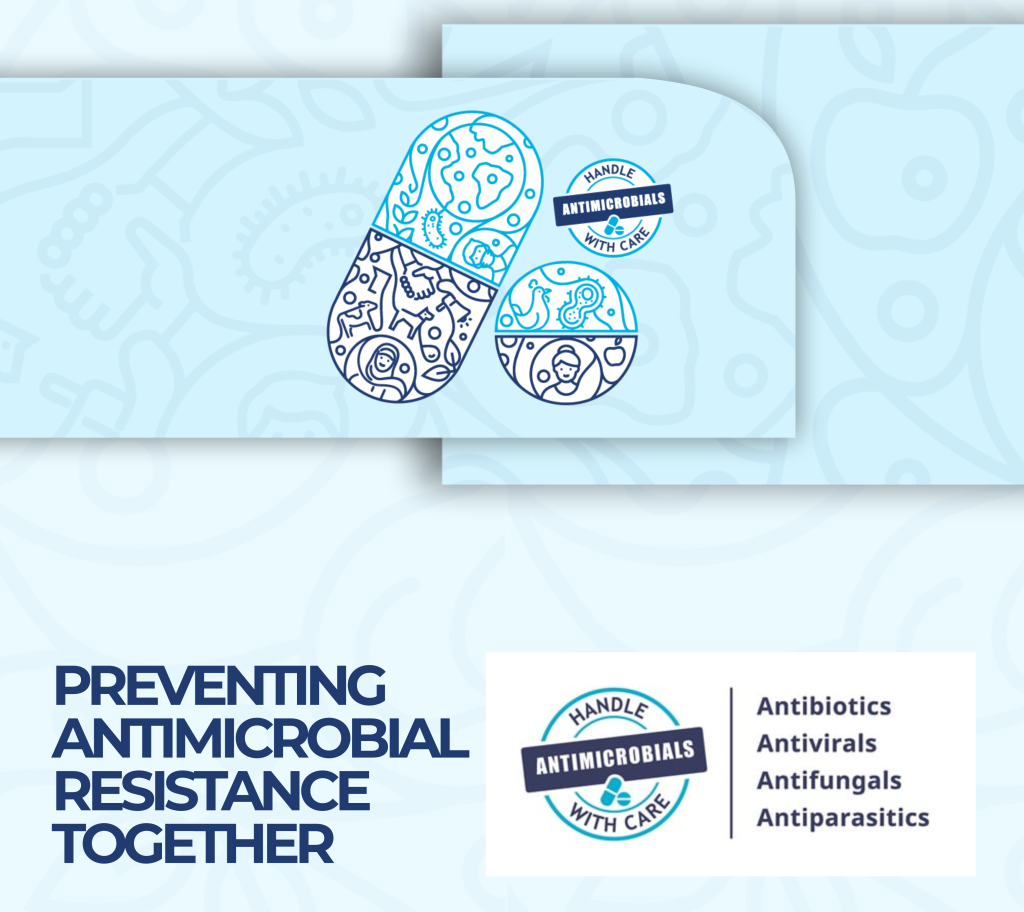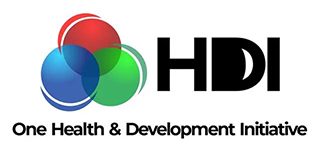One Health and Development Initiative (OHDI)

WHAT ARE ANTIMICROBIALS?
Antimicrobials are medicines used to prevent and treat infections in humans, animals, and plants. They work by inhibiting or killing germs (pathogens) which are microorganisms and parasites that cause infections. These germs include bacteria, fungi, viruses, protozoans, helminths, and nematodes. Examples of antimicrobials include antibiotics (for bacterial infections), antifungals (for fungal infections), antivirals (for viral infections), and antiparasitics (for pathogenic parasites).
WHAT IS ANTIMICROBIAL RESISTANCE?
Antimicrobial Resistance (AMR) is a phenomenon in which germs (pathogenic organisms such as bacteria, viruses, fungi, and parasites) are no longer killed or inhibited by medications (antimicrobials) designed against them. This is caused by changes manifested by the germs in response to antimicrobials over time. These resistant germs are usually called “superbugs”. The most prominent type of AMR is antibiotic resistance which is the resistance of bacteria against antibiotics.
CONSEQUENCES OF AMR
The main consequence of antimicrobial resistance (AMR) is that an infection caused by a resistant germ (pathogen) becomes harder or impossible to treat. This often leads to longer treatment periods, the use of stronger and more expensive last-line antimicrobials (which often have dire side effects), severe illness, and in extreme cases, failure of treatment that may lead to death. It also increases the risk of infection transmission – both between humans or from humans to animals and the environment (and vice versa)
The consequences of AMR have been increasing in occurrence and prevalence such that the World Health Organization (WHO) has declared AMR as one of the major global health threats in this century. In 2019, about 1.27 million deaths were caused by AMR and it is estimated that if proper actions are not taken, 10 million deaths will occur annually by 2050 (Antimicrobial Resistance Collaborators, 2022).
FACTORS CONTRIBUTING TO THE DEVELOPMENT OF AMR
Although AMR may develop naturally, it is facilitated by actions such as the misuse and abuse of antimicrobials in both humans and animals.
DEVELOPMENT AND TRANSMISSION OF AMR IN HUMANS
- Misuse of antimicrobials involves the use of antimicrobials when not needed or when not prescribed by a certified physician. It also includes the use of antimicrobials for purposes different from infectious diseases prevention and control. Examples of misuse include taking antibiotics for viral infections such as colds and using them as animal growth promoters or steroids on land farms or in aquaculture.
- Abuse of antimicrobials also involves overdose or underdose of antimicrobials. Examples include stopping the use of prescribed antimicrobials before completing the prescribed dosage, perhaps because of the feeling of wellness that sets in after taking medications for a while.
- Also, poor access to quality, affordable medicines, vaccines, and diagnostics can facilitate the development of AMR since it leads to poor infection and disease prevention and control in healthcare facilities and farms, thereby contributing to the development of AMR.
This misuse and abuse expose pathogens (germs) to antimicrobials unnecessarily and this speeds up the rate at which the organisms will adapt to and become resistant to antimicrobials. Misuse and abuse are often caused by a lack of knowledge on the appropriate use of antimicrobials in humans and animals and the resulting dangers of antimicrobial resistance.
DEVELOPMENT AND TRANSMISSION OF AMR IN ANIMALS
Antimicrobial resistance also develops when antimicrobials are used consistently in food-animal production to prevent or treat disease in food animals. This is usually done when people supplement animals’ feeds with antimicrobials in various doses. Oftentimes, the aim of this practice is to prevent disease in food animals. However, this constant use has contributed significantly to the development of resistant germs (pathogens) capable of causing infections in humans. When the pathogens in animals become resistant, they can be transferred to humans through direct contact, zoonotic infections, or the ingestion/consumption of infected animals and/or animal by-products.
DEVELOPMENT AND TRANSMISSION OF AMR IN THE ENVIRONMENT
- Improper disposal of wastes of infected animals and their carcasses also introduces resistant germs to the environment. This is particularly common in animals that have been subjected to antimicrobial abuse during production and management. In this case, subsequently, other pathogens of the same kind can acquire resistance and infect humans alongside previously resistant germs.
- Also, lack of access to clean water, sanitation, and hygiene for both humans and animals can lead to the spread of infectious diseases and facilitate the development of resistant germs (pathogens).
This interaction emphasizes the suitability of the One Health approach in tackling AMR since One Health recognizes and addresses issues at the interconnections between human, animal, and environmental health. It is therefore important to adopt One Health in tackling AMR and strengthen global efforts to prevent and control its spread in humans, animals, and the environment.
WHAT YOU CAN DO TO ADDRESS AMR
- Practice Good Hygiene and Sanitation – Maintaining good hygiene and a clean environment prevents infection and disease occurrence. If infections do not occur, germs (pathogens) are less likely to be introduced to antimicrobials thereby reducing their chances of adapting to them.
- Purchase and use antimicrobials (medications) only when prescribed by a certified physician. The irrational and indiscriminate use of antimicrobials leads to unnecessary exposure of germs to antimicrobials. Therefore, do not self-medicate.
- Comply strictly with an antimicrobial regimen during an infection. Follow the physician’s prescription completely and ensure full use of the prescribed dosage even if you have a feeling of wellness. This is important for antimicrobial use in both humans and animals.
- Educate other people on AMR and what can be done to control it. If more people have sufficient knowledge of AMR, then we can have more hands fighting against AMR.
- Desist from selling or purchasing substandard medications (antimicrobials) as they increase the chances of AMR.
- Do not share antimicrobials with friends and family.
- Desist from using antimicrobials as growth promoters or steroids in animal farms or aquaculture.
- Effluent wastewater from abattoirs and industries which often contain antimicrobials must be properly treated before being discharged into the environment.
Following the measures written above will help you combat AMR effectively, and keep you and your family safe from infectious diseases.
What Next?
As One Health-focused organization, OHDI is celebrating this year’s World Antimicrobial Awareness Week with several informative activities including scheduled webinars and social media campaigns. To take this further, we have concreted plans to continue this conversation in various secondary schools, communities, and among professionals in the human, animal, and environmental health sectors. This will be one of the many projects we shall be undertaking to create more engagement and youth action around the AMR discourse. OHDI will continue to contribute to the global efforts against AMR through advocacy (both physical and virtual), research, and corresponding projects. We are happy to receive external collaborations and support to mitigate AMR and its negative impact across the One Health spectrum.
REFERENCES
- Antimicrobial Resistance Collaborators. (2022). Global burden of bacterial antimicrobial resistance in 2019: a systematic analysis. The Lancet; 399(10325):P629-655. DOI: https://doi.org/10.1016/S0140-6736(21)02724-0
- World Health Organization. (2021, November 17). Antimicrobial Resistance. Retrieved from https://www.who.int/news-room/fact-sheets/detail/antimicrobial-
